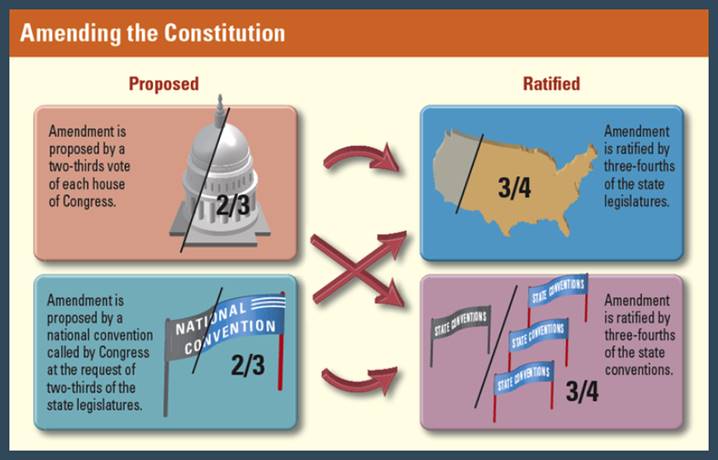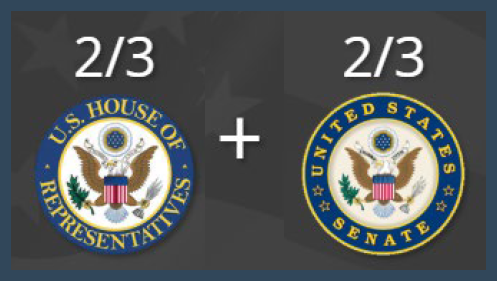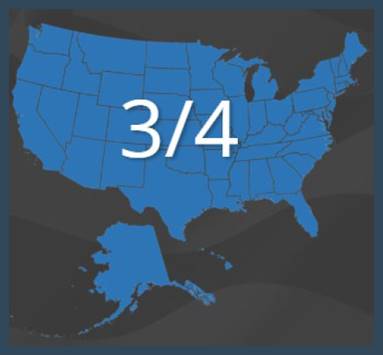Constitutional Changes

Unit Overview
In this
unit, students will describe how constitutional government has changed the
meaning of several of the basic principles that help define the United States
government. (CS#7).
Section A: Content Statement 7
Constitutional
government in the United States has changed over time as a result of amendments to the U.S. Constitution, Supreme Court decisions, legislation,
and informal practices.
Content Elaboration
The
operations of government in the United States take place within a framework
provided by the U.S. Constitution. However, the U.S. Constitution has been amended,
interpreted,
and implemented
in a variety of ways.
The
processes for formally amending the U.S. Constitution are outlined in the
document. Constitutional amendments have added to, modified, replaced, and
voided provisions of the original document and previous amendments.
The U.S.
Supreme Court, in deciding cases brought before it, has frequently
interpreted provisions of the U.S. Constitution to clarify and extend their meaning.
With its power of judicial review, the Supreme Court has also declared actions
of the branches and the states to be unconstitutional. The U.S. Congress, in
creating legislation, has provided details that build upon the framework of the
Constitution. For example, civil rights acts and voting rights acts have
provided specific directions to promote constitutional principles.
Informal
practices also have changed how the constitutional
government has been implemented in the United States. These practices are
related to provisions in the Constitution but venture into areas not explicitly
addressed in the Constitution. For example, legislative oversight of the
executive branch grew in part out of Congress’ need for information to help
draft new legislation.
Let’s Practice: Content Statement 7
Section B: Amendment Process
The
operations of government in the United States take place within a framework
provided by the U.S. Constitution. However, the U.S. Constitution has
been amended, interpreted, supplemented, and implemented in a variety of ways. The
“amendment
process” allows the Constitution to change with the country. It is a “living document.” The United States
Constitution has only 27 amendments that have been added
to the Constitution. The alternative
processes for formally amending the U.S. Constitution are outlined in Article V of the document.
Constitutional amendments have added to, modified, replaced, or made inoperable
provisions of the original document and previous amendments.
There is a
two-step process to add an amendment.
There is a common way and uncommon way.
1. Must first be proposed (two different ways)
2. Then ratified (two different ways)
|
Common Way |
|
|
Proposing an Amendment (Common Way) |
Ratifying an Amendment (Common Way) |
|
Congress proposes a constitutional
amendment |
Ratification is left
to the states – the federal government can’t change the Constitution on its
own. |
|
2/3 of both houses must
approve it
|
States ratify through their legislatures.
|
|
Then it goes to the states for ratification |
Each state votes to ratify.
¾ of the states must ratify. (38 out of 50 states) |
|
Uncommon Way |
|
|
Proposing an Amendment (Uncommon Way) |
Ratifying an Amendment (Uncommon Way) |
|
State legislatures call for
a Constitutional Convention |
States hold
special ratifying conventions. |
|
2/3 of state legislatures
(33 out of 50 states)
|
¾ of the conventions
vote to ratify
|
|
This proposed process has never happened in our history but is
listed as an option in the Constitution. |
This ratification process has only been used
once, to ratify the 21st amendment in 1933. Repealed
Prohibition |
Let’s Practice: Order of Amendment Process
Section C: Informal Amendment Process
There are
two kinds of amendments that change the Constitution.
1. Formal Amendment Process – an actual written, numbered amendment to the Constitution. Examples: Bill of Rights Amendments,
Reconstruction Amendments, Suffrage Amendments, and Presidential Amendments.
2. Informal Amendment Process – changes made over time without passing a Constitutional
Amendment. The vast majority of changes
to the Constitution have not changed the words in the Constitution.
Below is a
flipbook that will describe the five ways of the “Informal Amendment Process”
Let’s Practice: Informal Amendments



